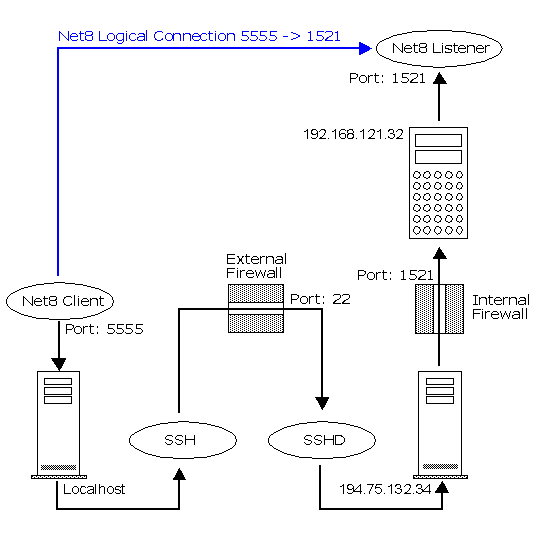![]() Net8 access trough a firewall with port forwarding using SSH
Net8 access trough a firewall with port forwarding using SSH ![]()
One option for secure communication between the Net8 client and server is to tunnel the communication inside the Secure Shell protocol.
Conceptually, it works like this. First, you install an SSH client on the local machine where you run your Net8 client. You use the SSH client to establish an SSH connection to the remote host where the Net8 server is running. You also use the SSH client to establish a "listen" on a local port for Net8 requests.
Here's the cool part: when you fire up your Net8 client, it connects to the Net8 port on localhost - your machine - instead of connecting to port 143 on a remote server machine.
The SSH client then forwards everything it receives on the local Net8 port through the SSH session, or tunnel, to the remote SSH daemon, which then forwards the data to the Net8 port on the remote host.
How does the SSH daemon on the receiving end know what to do with all this Net8 information coming at it? Well, the information is part of the port-forwarding arrangement you gave the daemon when you first fired up the SSH session. For example, you'd invoke SSH from your unix client machine like this
$ ssh -f -L localport:remotehost:remoteport tail -f /dev/null
Tfhe command must be invoked as root because root privilege is required to set up port forwarding. The -f option tells SSH to run in the background after port forwarding has been established. -L localport:remotehost:remoteport specifies that the given port on the local (client) host is to be forwarded to the given host and port on the remote side. In our example, we use port 5555 on the client and port 1521 on the database server 192.168.121.32
The server port must be whichever port listens for Net8 requests (1521 on most systems). Depending on the SSH client, you'll either be prompted for your password to log in to the SSHD 194.75.132.34 server when issuing the tunneling command, or you'll have to initiate a login manually to establish the session, In all cases, you'll have to use SSH to log in to the remote host before you can use it to "launder" your connection. The entire Net8 port-forwarding scenario is shown in the next figure.

Example
We start by using lsof (list open files), a program that tells you which open files and network connections belong to which processes. to check for software listening at local TCP port 5555. There is none. We confirm this by trying to telnet to localhost at port 555 without success.
$ lsof -i tcp:5555
$ telnet localhost
5555
At this point, we're certain that there's no activity, such as a listen or an open connection, on port 555 on our local machine. That port is okay to use. Next, we set up the port forwarding by issuing an SSH command. Remember that you have to be root to set up port forwarding:
$ su -
$ ssh -f -L 5555:192.168.121.32:1521
194.75.132.34 tail -f /dev/null
$ ps -ef
The tail -f /dev/null that we tacked on the end of the SSH command is just a low-overhead command to keep the session open. We didn't want to keep an actual shell session open and running in the background when we didn't need it, so we used the tail command instead. You can verify with ps -ef, that the command is now running in the background and you now have a permanent Net8 connection through two firewalls -- cool isn't it?
Next you have to setup your TNSNAMES.ORA configuration file, then check the connection with tnsping and finally connect with sqlplus.
ORA1.WORLD =
(DESCRIPTION =
(ADDRESS_LIST =
(ADDRESS = (PROTOCOL = TCP)(HOST = localhost)(PORT
= 5555))
)
(CONNECT_DATA =
(SERVICE_NAME = ORA1.WORLD)
(SRVR = DEDICATED)
)
)
$ tnsping ORA1
$ sqlplus scott/tiger@ORA1